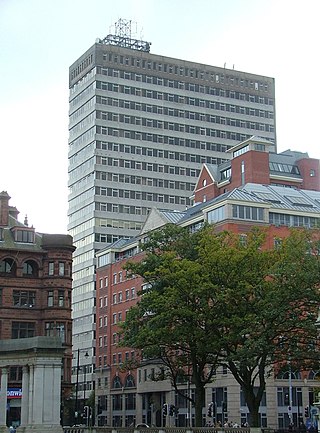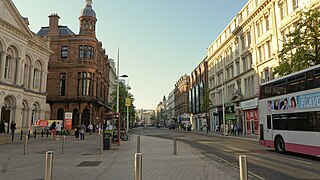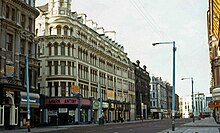
The French Quarter, also known as the Vieux Carré, is the oldest neighborhood in the city of New Orleans. After New Orleans was founded in 1718 by Jean-Baptiste Le Moyne de Bienville, the city developed around the Vieux Carré, a central square. The district is more commonly called the French Quarter today, or simply "The Quarter", related to changes in the city with American immigration after the 1803 Louisiana Purchase. Most of the extant historic buildings were constructed either in the late 18th century, during the city's period of Spanish rule, or were built during the first half of the 19th century, after U.S. purchase and statehood.

Bloody Friday is the name given to the bombings by the Provisional Irish Republican Army (IRA) in Belfast, Northern Ireland on 21 July 1972, during the Troubles. At least twenty bombs exploded in the space of eighty minutes, most within a half-hour period. Most of them were car bombs and most targeted infrastructure, especially the transport network. Nine people were killed: five civilians, two British soldiers, a Royal Ulster Constabulary (RUC) reservist, and an Ulster Defence Association (UDA) member, while 130 were injured. The IRA said it sent telephoned warnings at least thirty minutes before each explosion and said that the security forces wilfully ignored some of the warnings for their own ends. The security forces said that was not the case and said they were overstretched by the sheer number of bombs and bomb warnings, some of which were hoaxes.

Ballymun is an outer suburb of Dublin, Ireland, at the northern edge of the Northside, the green-field development of which began in the 1960s to accommodate a housing crisis in inner city areas of Dublin. While the newly built housing was state-of-the-art at the time, comprising high-rise tower blocks and flat complexes, residents were moved in years before shops, schools and other infrastructure were fully ready, and the area became well known for both a strong community spirit and considerable social challenges. Ballymun has several sub-districts such as Sillogue, Coultry, Shangan and Poppintree, and is close to both the Republic of Ireland's only IKEA store and to Dublin Airport. The area is the source of one Dublin river, and parts lie in the floodplain of another, and there are a number of parks.

York Road railway station served the north of Belfast in Northern Ireland. It was formerly one of the three terminus railway stations in Belfast. The others were Great Victoria Street, and Queen's Quay.
Belfast City Centre is the central business district of Belfast, Northern Ireland.

The Belfast Blitz consisted of four German air raids on strategic targets in the city of Belfast in Northern Ireland, in April and May 1941 during World War II, causing high casualties. The first was on the night of 7–8 April 1941, a small attack which probably took place only to test Belfast's defences. The next took place on Easter Tuesday, 15 April 1941, when 200 Luftwaffe bombers attacked military and manufacturing targets in the city of Belfast. Some 900 people died as a result of the bombing and 1,500 were injured. High explosive bombs predominated in this raid. Apart from those on London, this was the greatest loss of life in any night raid during the Blitz.

Northumberland Avenue is a street in the City of Westminster, Central London, running from Trafalgar Square in the west to the Thames Embankment in the east. The road was built on the site of Northumberland House, the London home of the Percy family, the Dukes of Northumberland between 1874 and 1876, and on part of the parallel Northumberland Street.

Windsor House was a 23-story, 80 m high-rise building on Bedford Street in Belfast, Northern Ireland. The building was the tallest storeyed building in Northern Ireland before being surpassed by Obel Tower and stands at 85 metres (279 feet) tall, with 28 floors. The total structural height is actually taller than the Obel, if you include the two plant floors and radio mast it stands at 93m(305ft) tall.

A coffee palace was an often large and elaborate residential hotel that did not serve alcohol, most of which were built in Australia in the late 19th century.

Lisburn Road is a main arterial route linking Belfast and Lisburn, Northern Ireland.
Seaview is a football stadium in Belfast, Northern Ireland. It is the home ground of Crusaders, and traditionally hosts the final of the Steel & Sons Cup on Christmas Day. The stadium holds 3,383, and has a 4G playing surface.

The Cathedral Quarter in Belfast, Northern Ireland, is a developing area of the city, roughly situated between Royal Avenue near where the Belfast Central Library building is, and the Dunbar Link in the city centre. From one of its corners, the junction of Royal Avenue, Donegall Street and York Street, the Cathedral Quarter lies south and east. Part of the area, centred on Talbot Street behind the cathedral, was formerly called the Half Bap. The "Little Italy" area was on the opposite side of Great Patrick Street centred on Little Patrick Street and Nelson Street.

Broadcasting House, Belfast is the headquarters of BBC Northern Ireland and operates many of its broadcasting services. The building is located on Ormeau Avenue in Belfast city centre, at the junction with Bedford Street. Public tours of the building are available.

Victoria Square is a shopping complex located in Belfast, Northern Ireland. The area includes over 62 shops, 16 restaurants and an Odeon cinema. Opened on 6 March 2008, Victoria Square is a commercial, residential and leisure development that took 6 years to build. Its anchor tenant is the largest House of Fraser that the retailer has opened in the UK, at nearly 200,000 square feet (19,000 m2).

The Linen Quarter is an area of Belfast, Northern Ireland. The name is derived from the great many linen warehouses that are still present in the area. The Linen Quarter is host to some of the major cultural venues of Belfast, including the Ulster Hall and Grand Opera House, alongside a large number of hotels, bars, restaurants and cafes. The district also includes the main transport hub of Belfast.

Great Victoria Street was a railway station that served the city centre of Belfast, Northern Ireland. It was one of two main stations in the city, along with Lanyon Place, and was nearest to the city centre. The station was situated beside Great Victoria Street and shared a site with the Europa Buscentre, Belfast's former main bus station. The railway and bus stations were replaced by the adjacent Belfast Grand Central station with the official opening on 13 October 2024. Great Victoria Street railway station closed permanently on 10 May 2024, with a bus transfer service operating until rail services commenced from Belfast Grand Central, with a service to Dublin at 8:05 a.m. on 13 October 2024. Europa Buscentre closed permanently on 7 September 2024, with bus services immediately transferring to the new station, commencing with a service to Dublin at 5 a.m. on 8 September 2024.

Royal Avenue is a street in the heart of Belfast city centre, Northern Ireland. It runs for about 500 metres from the junction with Castle Place and Donegall Place to the junction with Donegall Street. It lies between the Cathedral Quarter and the Smithfield and Union Quarter of the city. It has been the city's principal shopping thoroughfare since its establishment in 1881. Today Royal Avenue is one of Belfast's main commercial centres and is home to the £40 million shopping complex Westfield CastleCourt.

Great Victoria Street in Belfast, Northern Ireland, is a major thoroughfare located in the city centre and is one of the important streets used by pedestrians alighting from Belfast Great Victoria Street railway station and walking into shopping streets such as Royal Avenue.

The War Memorial Building is a grade B2 listed building in Belfast, Northern Ireland. The building, modernist in design, was constructed in 1959–1962 on the site of a hotel destroyed during the 1941 Belfast Blitz. The building was formally opened by Queen Elizabeth The Queen Mother and housed organisations and charities related to the British armed forces. The site currently lies empty and has been placed on the Heritage at Risk Register. The current owners have applied for permission to convert the building into a 120-bedroom hotel.


















